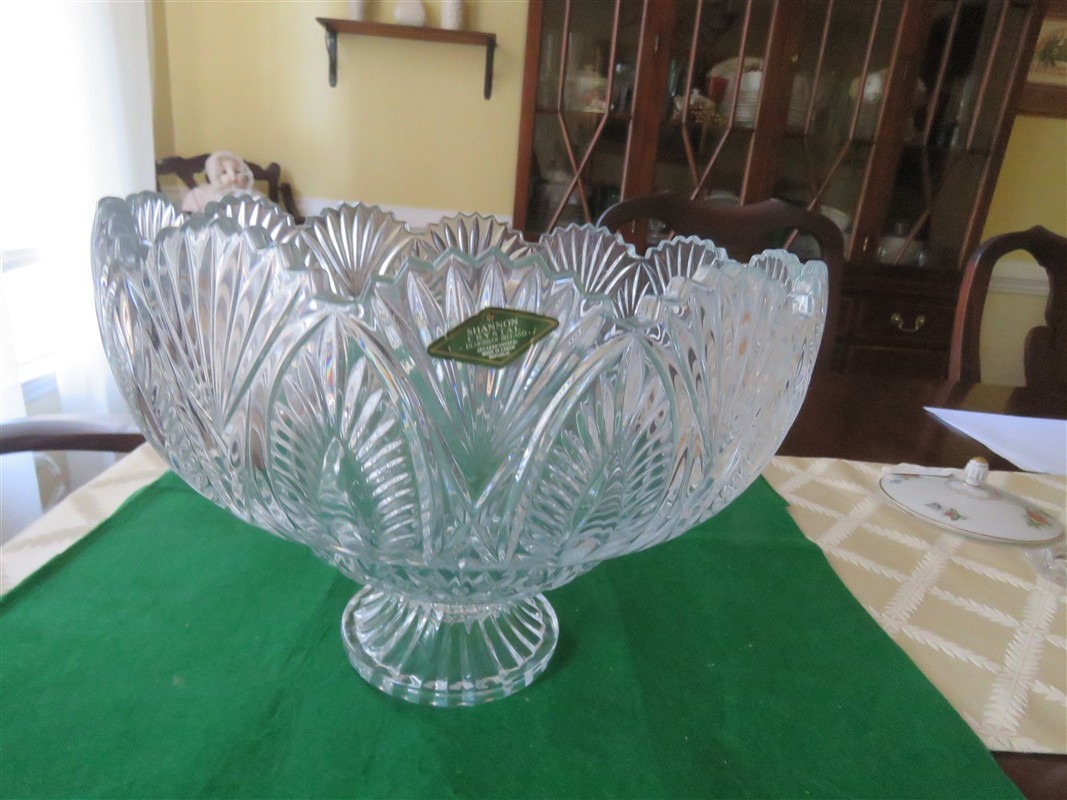🔹 What is Leaded Glass?
-
Definition: Glass that contains lead oxide (usually 18–40%). At 24% or more, it’s typically classified as lead crystal.
-
Qualities: Heavier weight, brilliant sparkle, and that clear bell-like ring when tapped.
-
Uses: Found in plates, bowls, serving dishes, and complete dinnerware, as well as stemware (wine glasses, goblets, champagne flutes, cordials, etc.).
🔹 Collectible Styles & Eras
-
Victorian & Edwardian (late 1800s–early 1900s)
-
Heavy cut-glass bowls, plates, and goblets.
-
Elaborate etched or wheel-cut patterns.
-
-
American Brilliant Period (1876–1917)
-
Renowned for deep, sharp cutting and dazzling brilliance.
-
Includes serving dishes, tumblers, and stemware (wine, sherry, and water goblets).
-
-
Art Deco (1920s–1930s)
-
Streamlined geometric designs.
-
Popular for cocktail glasses, martini stems, and elegant serving pieces.
-
-
Mid-Century Modern (1940s–1960s)
-
More factory-pressed crystal patterns, less labor-intensive.
-
Cocktail culture fueled production of wine and cocktail stemware.
-
-
Post-War to Contemporary (1950s–1980s)
-
Luxury makers (Waterford, Baccarat, Orrefors) created matching dinnerware and stemware sets.
-
Brides and entertainers often registered for complete collections.
-
🔹 Famous Makers
-
Waterford (Ireland) – extensive stemware lines (Lismore, Colleen, etc.) and tableware.
-
Baccarat (France) – refined stemware and serving sets, highly collectible.
-
Lalique (France) – sculptural stemware with frosted and etched designs.
-
Bohemian/Czech Crystal – cut-to-clear stemware and plates in rich colors (ruby, cobalt, emerald).
-
American Brilliant Cut Glass makers (Libbey, Hawkes, Tuthill) – prized for quality stemware and serving ware.
🔹 What Collectors Value
-
Clarity & sparkle – free of clouding, chips, or scratches.
-
Sharpness of cut – wear dulls older pieces.
-
Matching sets – full stemware suites (water, red/white wine, champagne) and dinnerware together add value.
-
Maker’s mark/acid etching – not all pieces were signed, but identification boosts desirability.
-
Pattern rarity – discontinued or hard-to-find stemware patterns can bring high prices.
🔹 Safety Considerations
-
Short-term use (serving wine, cocktails, or meals) is fine.
-
Long-term storage (like keeping wine or juice in a crystal decanter) is not recommended because lead can leach into liquids.
-
Many collectors display their stemware and dinnerware rather than using it daily.
🔹 Market Trends
-
Stemware is often more sought after than plates or bowls, since people buy it for entertaining.
-
Complete services (12 water goblets + wine + champagne + serving dishes) sell well to upscale vintage buyers.
-
Younger buyers gravitate toward standout stemware for bar carts, cocktail culture, or decorative display.
-
High-end crystal (Waterford, Baccarat, Lalique) still commands strong resale values.
🔍 Collector’s Guide: Identifying Leaded Glass (Dinnerware & Stemware)
1. The Ring Test
-
Tap the rim lightly with your fingernail or a utensil.
-
Leaded glass / crystal: produces a long, clear, bell-like ring.
-
Regular glass: dull, flat “thunk” sound.
2. Weight Check
-
Leaded glass feels heavier than standard glass of the same size.
-
A crystal wine goblet, for example, feels solid and weighty compared to a soda-lime glass goblet.
3. Brilliance & Sparkle
-
Hold the piece up to light:
-
Leaded crystal refracts light strongly, producing a prism rainbow effect.
-
Regular glass looks plainer, less sparkly.
-
-
Faceted cuts in crystal “dance” with rainbow colors, especially under natural or spotlighting.
4. Cut & Craftsmanship
-
Crystal stemware and dinnerware often have:
-
Deep, sharp hand-cut or wheel-cut patterns (especially in American Brilliant and Waterford).
-
Smooth, finely polished rims.
-
-
Pressed glass has:
-
Mold seams, shallower or blurred designs.
-
A less precise finish.
-
5. Thickness & Clarity
-
Crystal is often thinner at the rim but still strong due to lead content.
-
High-quality crystal has exceptional clarity, almost water-like.
-
Cheaper glass may appear slightly greenish or cloudy.
6. Maker’s Marks
-
Many manufacturers etched or acid-stamped marks on the base. Examples:
-
Waterford – Script or gothic “Waterford” etching.
-
Baccarat – Circular mark with name.
-
Lalique – “R. Lalique” on earlier pieces, “Lalique France” on later.
-
-
Some older or smaller makers left pieces unmarked, so tests above matter.
7. Sound of a Flick (Stemware-Specific)
-
Hold a goblet by the bowl, flick the bowl lightly.
-
True crystal resonates with a sustained musical tone.
-
Glass produces only a short, dull sound.
⚠️ Safety Reminder
-
Safe for occasional serving, but don’t use for long-term storage of liquids (like keeping wine in a decanter). Lead can leach over time.
✅ Quick At-Home ID Checklist
-
Heavy for size
-
Clear, brilliant sparkle with rainbow effect
-
Long, bell-like ring when tapped
-
Sharp, precise cutting (not blurred or molded)
-
Thin but strong rim
-
Acid-etched maker’s mark (when present)


